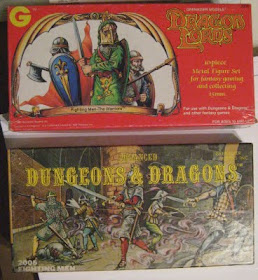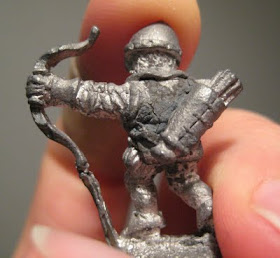Lead rot. A nasty business, actually it's heart-breaking. And older minis are very susceptible to this affliction which as good as destroys them.
Mike Monaco wrote up a nice piece here about lead rot. For those of you who know what it's like, you can sympathize, but for those who have not seen it, below are some excellent examples of in-progress rot, eating away at some classic Grenadier minis.
Here are two sets, both Grenadier's Fighting Men (red box series came out after the original AD&D sets, so the bottom one is the older one).
Online auctioneers who are selling metal soldiers may think of them as just that, a box of metal soldiers. They are most likely not aware of the condition they are in and so do not include that in their descriptions. No hard feelings, it is what it is. (in this case the seller didn't know much at all, several of the figs are not even part of this set, they're strange orphans from other Grenadier sets or blisters - I'll have to spend some time trying to ID them) I was annoyed though, to say the least. I bought the red-box version some months ago, and three out of the ten figs were afflicted. So I spent a little time looking for a duplicate set to replace the nasty figs. I got the original AD&D set and it came in the other day. My heart sank when I opened the lid and saw the awful dark gray, it was pretty bad, in fact this was the worst I've seen so far. Here are the ghastly images:
Terrible
Looks like a disease of some kind, the rot bubbles up...
Nasty
You can actually see the cracking in this image, it's like what happens to the people in Lovecraft's The Colour Out of Space
Gross
More cracking on the archer. Curious where the rot starts on some of the figures...
Disgusting
The year and company inscription barely visible... green stuff too, not the good kind...
Hideous
Simply awful, once a nice flat shield, now a pizza-like moonscape, the likes of which might be seen on Dorian Grey's mug shot...
This one was interesting because the figure is not yet physically deformed, but the shades of gray appearing foretell how things will go. Now that these are with me they will be properly stored, hopefully progress of the rot will be arrested.
Restoration? Possible, but tricky. It will take some drilling and some putty-filling and re-sculpting. Thankfully I have other castings (red box version) that I can work from.
Tread carefully with online purchases. I got burned here. Not only because of the lead rot but because several of the figs are not from this set. It was a gamble buying them, but that's how it goes sometimes. No hard feelings. Get those old minis out of the garage and the attic and into more decent conditions.
Some more info here.








Hey, thanks for the props and for posting your cautionary tale.
ReplyDeleteMan, I hate to see minis turning to dust.
How do you plan to remove the lead rot -- vinegar, baking soda, sometihng else? I've never tried any of the methods suggested by various web sites.
Mike sent me and I'm glad he did. Excellent blog on a subject lesser dealt with. Reading and viewing pleasure ahead.
ReplyDeleteIt is rather an unknown topic, so I was happy when I found Mike's article. As far as restoration I believe the best procedure is to drill out the rotted areas, kind of like a tooth cavity: remove the bad a replace it with a filler. In this case it might be Kneadatite Brown, Green may suffice. But I would literally be filling and the re-sculpting the details. I’ll probably try on a simpler case of rot to see how it goes. I’ll certainly post the results and in-progress here. Thanks for reading.
ReplyDeleteFrom other blog posts from collectors i've read the main cause of lead rot is keeping lead figures in containers or cabinets that don't allow enough air in. There's also a way to halt lead rot (though not reverse it)
ReplyDeletehttp://www.bugmansbrewery.com/topic/8397-some-aspects-of-leadrot/